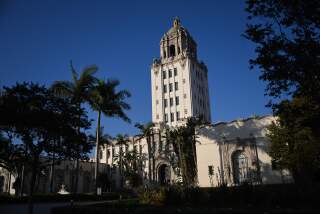Highrollers are folding in Sin City
- Share via
FIRST, the Icon Las Vegas was derailed, then the Hard Rock Hotel and Casino expansion and now the Curve. What’s up with Sin City’s luxury high-rise condo market?
In the last several months, at least seven marquee Las Vegas condo projects have either been canceled or put on hold, causing a dust storm of rumors to swirl through the city and elsewhere as investors wonder if this is a harbinger of a slowdown. The reasons for the projects’ retreats don’t bode well for the larger picture: lack of buyer interest and escalating land, construction and labor costs.
But is this really the beginning of the end of the Vegas market? Experts say no and are eager to put things in perspective -- an act made more difficult by the fact that the latest high-profile project to halt sales is the $3-billion Las Ramblas luxury hotel and condominiums. The planned casino, boutique hotel and sprawling residential project, backed by actor George Clooney and partners, was to include 11 towers on 25 acres. The resort was billed as a throwback to a bygone era when jackets and dresses were de rigueur at dinner. Today, its future is anybody’s guess.
The Las Ramblas reorganization, announced in March, comes on the heels of the cancellations of the Aqua Blue, Krystal Sands and Icon Las Vegas. Ivana Trump’s eponymous project, Ivana Las Vegas, is also said to be regrouping, as are the Curve -- a proposed mixed-use project with twin 18-story luxury towers on 45 acres -- and the Hard Rock condo project, once scheduled to be built next to its hotel and casino, which now are up for sale. The fate of the latter project depends on the new buyers, industry watchers say.
Spiraling costs are a major culprit. Developers who locked in construction prices are faring better. Those who didn’t lock in report that the costs of labor and materials have at least doubled in the last couple of years because of a shortage of workers and worldwide demand for cement and steel, said Brian Gordon of Applied Analysis, an independent Las Vegas real estate market analysis firm.
Speculators also have played a role in the current high-rise slowdown. Buyers looking to flip units for a profit, rather than make Las Vegas a first or second home, flooded the market in 2004, raising prices. Most are expected to sell the units when the projects open their doors, some as early as this summer, said Bruce Hiatt, the owner of Vegas-based Luxury Realty Group. At least 20% to 30% of the units were sold to speculators.
Then about six months ago, speculator interest shifted to other markets, which created a shortage of buyers for the latest Vegas projects. Rising prices and a glut of condos contributed to the exodus.
“The market needs more first-, second- and third-home buyers, rather than flippers,” Hiatt said. “This will stabilize the market.”
To launch most condo and condo-hotel projects, a percentage of the units typically are pre-sold by developers to help finance the construction. The Curve ran into trouble when the developers couldn’t sell their pre-construction target of 75% of the units, said Paula James, Curve’s vice president. Some experts believe that the project was a harder sell because of its location near the busy Las Vegas beltway and auto malls.
With the sales office now dark and the well-dressed sales force gone, the company has returned deposits to the 97 buyers with a note saying sorry. The buyers, however, were offered a 150-day extension of their contracts in case the project resumes or new developers take over.
Sally and Mel Goldberg, of Tucson, who put a deposit on a Curve condo a year ago, quickly cashed their check and purchased a condo at the soon-to-be-built Cosmopolitan, a 64-story luxury high-rise condo-hotel next to the Bellagio.
“I didn’t feel good about the vibe [at the Curve],” said Mel Goldberg, a frequent Vegas visitor who has bought two other Vegas condos that are under construction. “So I took the money and ran.”
Jim Stuart, co-founder of Las Vegas’ Centra Properties and a partner in the Las Ramblas deal, said that not only is that project on hold, but he also has postponed development of other land acquisitions for now.
“The high-rise market is catching its breath,” Stuart said. “People are scratching their heads, trying to find the right formula for success.”
Even with the departure of a few major players, Vegas development is far from stagnant. About 61,000 condo units in the city are under construction or planned for future development. About 45,400 of them are planned for the Greater Las Vegas Valley, which includes the boom cities of Henderson, North Las Vegas and Summerlin, according to Gordon. About 15,600 units are under construction today and will open in the next five years.
But without question, the change of course of the marquee players has rumors flying that investor exuberance for high-rise luxury projects is on the wane.
“It raises everyone’s eyebrows when this happens,” said John Restrepo, a principal at Vegas’ Restrepo Consulting Group.
It’s no wonder some projects are foundering, considering the high cost of construction. To make a profit on high-rise projects starting construction today, developers have to charge at least $800 per square foot for luxury condos, or $960,000 for a 1,200-square-foot living space. The square-foot price for condos already under construction is $500 to $700, compared with $300 to $500 for projects such as Park Towers and Turnberry Place, which were built five years ago.
Adding to the condo competition are deep-pocketed casino-hotel owners able to pay cash for expansions. They lock up the limited number of experienced Vegas contractors.
Also, the shortage of Las Vegas construction workers has spurred developers to import laborers from California, Arizona and other Nevada cities. About 11,000 construction-related employees were added to the Vegas labor pool in the last 12 months, according to Applied Analysis.
Despite the setbacks, the Greater Las Vegas housing market has good long-term potential, developers and building consultants say.
The greatest consumer demand is for mid-rise buildings -- up to about six stories -- with pools and garden patios, away from the central entertainment corridor.
Interestingly, as single-family-home prices have skyrocketed in the Las Vegas suburbs, builders have begun eyeing land closer to the downtown area. These projects are designed for those who want to live near their work and don’t mind sacrificing individual backyards for community parks, pedestrian areas and lower prices, Centra’s Stuart said.
But for now, with apologies to the city’s well-known marketing slogan, real estate investors elsewhere are hoping that what happens in Vegas stays in Vegas.
More to Read
Inside the business of entertainment
The Wide Shot brings you news, analysis and insights on everything from streaming wars to production — and what it all means for the future.
You may occasionally receive promotional content from the Los Angeles Times.










